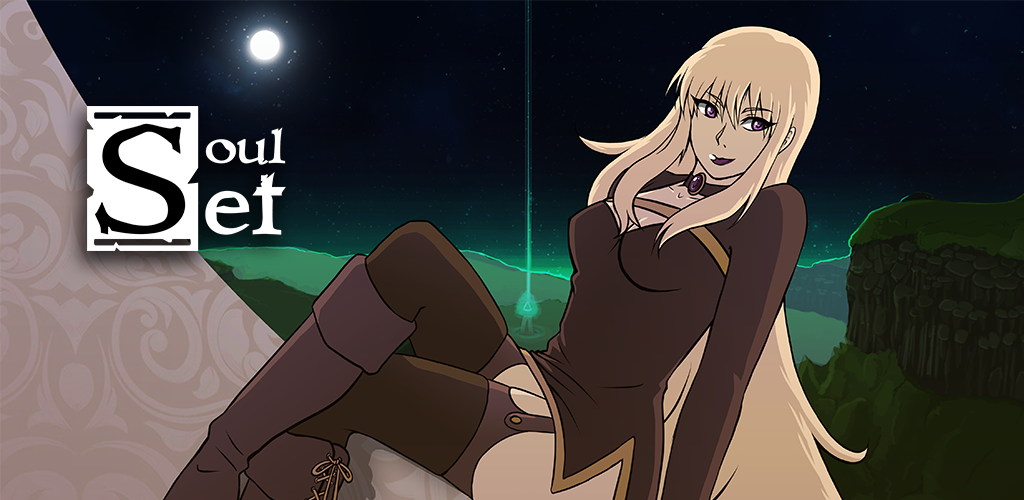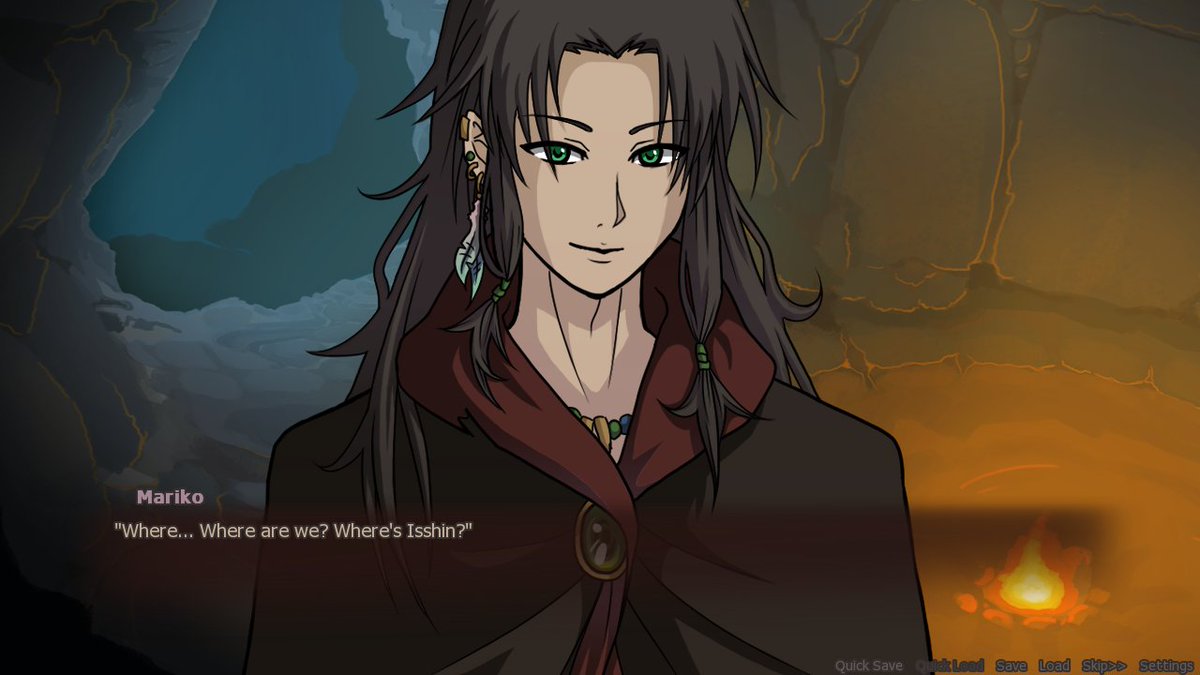
Note: I was provided with a free review copy of this game by the developer. All opinions expressed here are solely my own.
The multi-route mystery VN is not a format easy to pull off properly and for that reason not many EVN developers even attempt to tackle it. It requires creating a number of paths and characters, all interesting on their own and complementary to each other, while also keeping the overall quality high enough to motivate the reader to go through all of it in order to piece together the overarching story. This is both a challenge from the writing perspective and requires a fairly substantial amount of content to communicate the mystery effectively – usually, more than an average Western visual novel can provide with the humble resources at its creators' disposal.
Still, all this makes exploring the few examples of such games done right by Western devs that more interesting. SoulSet, developed by NoBreadStudio and released on Steam in late 2016 is a particularly “orthodox” implementation of the formula, with every route and ending (including bad ones) adding to your understanding of the story and culminating in an unlockable “true route”, which resolves the crucial mysteries and tie all the previous paths together. It’s also, as I will try to argue, a damn fine game that positively stands out in the EVN market, in a few ways.
Still, all this makes exploring the few examples of such games done right by Western devs that more interesting. SoulSet, developed by NoBreadStudio and released on Steam in late 2016 is a particularly “orthodox” implementation of the formula, with every route and ending (including bad ones) adding to your understanding of the story and culminating in an unlockable “true route”, which resolves the crucial mysteries and tie all the previous paths together. It’s also, as I will try to argue, a damn fine game that positively stands out in the EVN market, in a few ways.

The cast is among the better ones you can find in EVNs – even if a particular character isn’t very interesting by themselves, their backstories and secrets are extremely fun to explore
One of the first things that will catch your attention after starting SoulSet is the presentation. It has a rather original, pleasant-looking artstyle with a slightly Western feel to it – one of those “hybrid” aesthetics that definitely stand out from generic anime-style VNs, but also not don’t completely hide its Japanese roots. It also imminently sets up the tone of the story, with a fairly dark opening – a flashback that shows our protagonist, Mariko, after her family estate was raided and her loved ones killed, with a dying servant, a black dragon named Isshin, by her side. Later, she wakes up in an unfamiliar basement, with no memory beyond that particular dream and looking at least a decade older. Along with five other people trapped in a mansion, she has to uncover the reason she’s there and find a way out, while dealing with the confusion and distrust within the group.
The cast is varied and quite memorable, partially thanks to the distinct, mature designs which are pretty far detached from the usual “high-school student” aesthetic, often plaguing VNs regardless of the setting. All members of the main cast, including the protagonist, are quite well fleshed-out, with characteristic speech patterns and personalities, which in turn lead to some fairly unique scenarios and interactions in their respective routes. They also, of course, all hold various secrets, ones which both present various threats to the group and are necessary for you to uncover in order to solve the main intrigue – and necessary is not an overstatement, as you have to go through every route and most of the endings to reach the true conclusion of the story. Your progress is measured through “clues” you gather along the way – they persist between playthroughs and unlock new paths every time you gather a full set connected with a certain character (distinguished by colours). In specific cases, they might be needed to get a good ending, unlock extra path or even access a particular route altogether, forcing you to explore the game until you get all the necessary information and effectively experience all of the content it has to offer.

SoulSet’s intrigue is complex and satisfying to uncover, but leaves surprisingly many questioned unanswered and some subplots strangely underutilized
If you look from the outside, there’s one problem that comes up at this point – in a VN in which every character is romanceable and every route is pretty much obligatory, people could easily be forced into configuration they’re less comfortable with or romancing characters they don’t care about (in my case, for example, it would be Apris, definitely the blandest character in the group). The game deals with it in an elegant manner, with positive friendship ending being always available and actual romance fully optional – even though romantic endings for each character are considered the “true” ones, no clues are tied to them, so they’re not necessary to finish the game, unless you’re hell-bent on 100% completing it. There are also purely text-based erotic scenes in the romantic routes, but no visuals or descriptions explicit enough to make the reader uncomfortable – I find developer's approach to this whole side of the experience highly commendable, even though with the female protagonist the risk of romance scenarios being off-putting to some readers probably wasn’t that high.
The routes and romance scenarios themselves are, in my opinion, highly enjoyable and as I've mentioned before, they differ significantly from each other. While I usually enjoy the yuri content the most, here Shira, the character with a “secret” connected to their gender, was possibly my favourite, being initially combative and foul-mouthed, but having a shy and extremely cute side that quickly comes to view in reaction to Mariko’s flirting. The tone of the routes also varies a lot, with Yvonne’s being simply cute and heart-warming, while Shirr’s or Apris’ scenarios having very dark undertones (they can even go into arguably villainous paths for the protagonist). While SoulSet's overall reading time is quite substantial for an EVN (circa 15 hours) and the game replayed the same basic scenario every time, I never really got bored of it, always enjoying the new interactions and new pieces of the puzzle that every new path rewarded me with. And that goes even for the bad endings, which I usually avoid, but which here were given special significance by the clue system and felt like means to an end, rather than a pointless source of angst I usually take them for.

Good visual design and expressive sprites do a lot to make the game immersive and memorable
Genuinely, there are very few negative things I can say about this VN. It’s a really enjoyable experience, crafted with a lot of care and attention to detail. Among the Western visual novels there are very few that pulled off the multi-route mystery to a similar success – and among those, only Everlasting Summer gave me a similar enjoyment (although it’s much more of a classic waifu game than SoulSet). It could probably benefit from the larger amount of CGs and there are some clear inconsistencies between some of those and the sprites when it goes to artstyle, as they were done by a different artist. Some parts of the intrigue and details of Mariko’s backstory are a bit confusing or never explained properly, leaving you with some questions that really would be worth answering even after 100% completing the game. In general, though, it was a great experience and I strongly recommend it to everyone that has a liking for mystery VNs, or good romance stories with mystery elements – depending on how you approach it, it might work as both, without really ever feeling lacking.
Final Score: 4/5Pros:
+ Well-developed multi-route mystery
+ Memorable characters
+ Thoughtful approach to sex and romance
+ Good visual assets
Cons:
- Can be confusing without a guide
- Leaves too many details unexplained
VNDB Page
Buy SoulSet on Steam

Agree with all the points of the pros... except the good visual assets. This is just opinion - and of course, what I think is jarring or "not pleasing" can be perfectly great for anyone else... but I found that the shift between the two *very distinct* types of art (Sprites were Anime-esque, CGs were definitely westernized looking) really yoinked me out of the story. It's like you can get used to one or the other... and convince your brain "this is what attractive is in this game, okay".
ReplyDeleteHonestly... the paperdoll sprites, although not as 'finished' as some other works (with way higher budgets, so I get it)... were pretty/handsome/aesthetically pleasing.
I found the CG to make the characters look more... homely, everyone had a snub/round or hobbit-ish nose... which is something I could have acclimated to if they constantly looked like that, but in comparison to the sprites, I did not find it attractive at all.
Of course - again, just an opinion. I tend to like looking at Anime-type animation a million times more than western animation anyhow (unless we're talking Batman: The Animated Series type of animation or VERY high quality HIGH budget Marvel-type animation).
Pardon me for posting this... just it's REALLY bugging me during gameplay... had to write this opinion somewhere. Inconsistent artwork... ARGH.